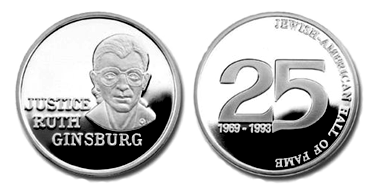|
|
INDEX
People
Abravanel,
Don Isaac
Berg, Gertude (Molly Goldberg)
Berg, Moe
Berle, Milton
Berlin, Irving
Bernstein, Leonard
Brandeis, Louis D.
Cardozo, Benjamin
Einstein, Albert
Elion, Gertrude
Frankel,Jacob
Gershwin, George
Ginsburg, Ruth Bader
Gompers, Samuel
Goode, Alexander
Goodman, Benny
Gratz, Rebecca
Greenberg, Hank
Hillman, Sidney
Hoffman, Jeffrey
Houdini, Harry
Jefferson, Thomas
Karpeles,
Leopold
Lamarr, Hedy
Lazarus, Emma
Lehman, Herbert H.
Levy, Asser
Levy, Uriah P.
Magnes, Judah L.
Meir, Golda
Miller, Arthur
Myerson, Bess
Noah, Mordecai.
Ochs, Adolph
Pulitzer, Joseph
Resnik, Judith
Rose, Ernestine
Rosenthal, Robert
Ross, Barney
Salk, Jonas
Salomon, Haym
Santangel, Luis de
Sarnoff, David
Schick, Bela
Seixas, Gershom M.
Singer, Isaac B.
Stern, Isaac
Straus, Isidor & Ida
Strauss, Levi
Streisand, Barbra
Szold, Henrietta
Torres, Dara
Torres, Luis de
Touro, Judah
Wacks, Mel
Wald, Lillian
Washington, George
Wiesel, Elie
Wise, Isaac Mayer
Zacuto, Abraham
|
 |
|
| Ruth
Bader Ginsburg (b.1933)
  |
Medal by Eugene Daub (2013), Supreme Court Justice Ruth Bader Ginsburg. |
When Ruth Bader Ginsburg was
appointed by President Bill Clinton and sworn in as the 107th justice to the
United States Supreme Court on August 10, 1993, she became the second woman
justice (Sandra Day O'Connor was the first) and the first Jewish woman ever to
sit on the Court. The first Jewish Supreme Court Justice had been Louis
Brandeis, appointed by President Woodrow Wilson in 1916.
President Clinton announces his selection of
Ruth Bader Ginsburg for the Supreme Court.
Calling Ginsburg’s appointment “the most significant and thrilling Jewish-American event of the year,” the Jewish-American Hall of Fame issued a special medal in her honor, that also commemorated its 25th anniversary. The 39mm 1 oz. pure silver medals were designed by Hal Reed, winner of the American Numismatic Association’s Numismatic Art Award for Excellence in Medallic Sculpture. After receiving the commemorative, Justice Ginsburg wrote: "I was touched beyond description … and cherish the special medal."

Twenty years later, Supreme
Court Justice Ruth Bader Ginsburg was selected as the 2013 Jewish-American Hall
of Fame honoree by a distinguished Advisory Board of leading Jewish historians
and organizational leaders. The Ginsburg medal crowns a year of impressive
achievements for sculptor Eugene Daub, who earlier this year received an
Honorary Doctorate from the Academy of Art, University of San Francisco and
attended the dedication of his statue of Rosa Parks in the National Statuary
Hall in the United States Capitol – the first full-sized statue authorized and
funded by Congress since the 1870s.
The over 2” diameter Ruth
Bader Ginsburg medals have the distinctive rounded-trapezoidal shape, created
by sculptor Victor Ries, that has distinguished the Jewish-American Hall of
Fame series since it was launched in 1969. The reverse features Moses, holding
the Ten Commandments—represented by the first ten letters of the ancient Hebrew
alphabet. The great lawgiver is based on a sculpture by Hermon MacNeil in the
eastern pediment of the Supreme Court Building. Inscribed is an extract from
Ginsburg’s remarks when she received the Albert D. Chernin Award given annually
by the Jewish Council for Public Affairs: “I am a judge, born, raised, and
proud of being a Jew. The demand for justice runs through the entirety of the
Jewish history and Jewish tradition.

Three great
lawmakers in the eastern pediment of the US Supreme Court Building were carved
by Herman A. McNeil--Moses is in the center, Confucius on the left, and Solon
on the right.
Ruth Bader Ginsburg was born
in Brooklyn on March 15, 1933. She was an excellent student in school, and was
confirmed with honors from the East Midwood Jewish Center. At James Madison
High School, she played the cello in the orchestra, was a member of Arista, was
a cheerleader and a baton twirler, and the school newspaper editor.
Ruth Bader in her high school year book.
One of only nine women at
Harvard Law School in 1956, Ginsburg and her female classmates were asked by
the dean why they were occupying seats that would otherwise be filled by men.
After transferring and graduating
(tying for first in class) from Columbia Law School, Ginsburg became the second
woman to join the faculty of Rutgers Law School. When she discovered that her salary was lower than that
of her male colleagues, she joined an equal pay campaign with other women
teaching at the university, which resulted in substantial increases for all the
complainants. Prompted by her own experiences, Ginsburg established the ACLU
Women's Rights Project in 1972 so that “artificial barriers are removed, and
avenues of opportunity [are] held open to women.
The National Women’s Hall of
Fame sums up Ginsburg’s service on the Supreme Court as: “Justice Bader
Ginsburg has become known for her scholarly, balanced opinions and forthright
personal courage. A cancer survivor herself, she has assisted thousands by her
example of frank discussion of the state of her health and early diagnosis.”

Supreme Court official photograph, 2012.
Click Here
to Take Ruth Bader Ginsburg Quiz
Go to page: First Page Previous Page
Next Page
|